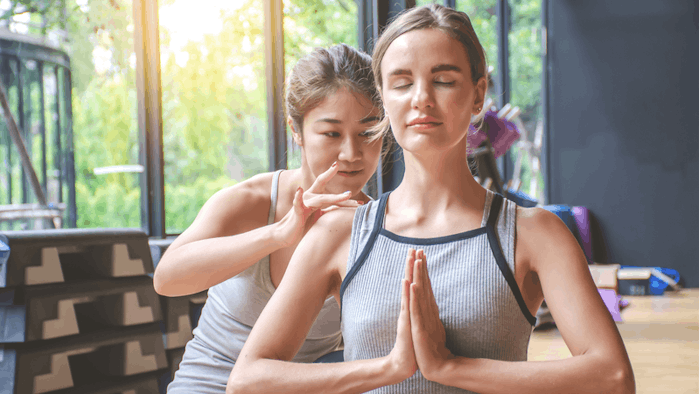
Spa-goers and wellness seekers are demanding more holistic experiences from professionals, and that demand has grown to include movement classes like yoga. Spas and wellness centers can rise to the occasion by intentionally engaging all five senses during their yoga classes, which is a great way to treat the whole human and ultimately results in a completely sensorial experience for clients.
Amanda Boles, massage therapist, yoga fitness instructor and founder of Spa Asana LLC, discussed this in her Face & Body Northern California advanced education session, "Engaging the Senses to Transform Your Yoga Class Into a Yoga Experience." Boles broke down how the five senses can impact students' motor learning and motivation, and she offered the following suggestions for bringing them into yoga practices to elevate them into fuller, whole-body experiences.
1. Sight
Color can be used to motivate yoga students, so be aware of your décor and even what colors you're wearing, as these things can have subtle effects. For instance, soft pastels are more soothing, whereas bold bright colors are more energizing.
Lighting can impact mood. You can dim the lights for savasana (corpse pose), or just for a more relaxing/restorative class. Conversely, brighter lights are ideal for more active classes with lots of movement.
Cueing is also a visual way to impact students' motivation. This can include demonstrating your moves and your body language in general, so be aware of what your body is saying. Cueing can also be a reinforcement visual, like inspirational posters or pretty quotes on the wall.
2. Taste
Yoga instructors can use taste to create awareness or mindfulness, for example, a "chocolate meditation" where you do a sweet mindful eating exercise before class. Or, incorporate certain foods for their benefits: Mint decreases blood lactate levels (allowing people to work out a little harder) versus chamomile tea, which will help them relax. A treat can be offered at the end of class, or as a distractor in more tough or active sessions.
3. Smell
Perhaps the most intuitive sense to incorporate, smell is best addressed with aromatherapy that can inform a practice. Again, consider the class and use scents that will enhance the overall experience, like stimulating scents for active classes and sedating ones for more relaxing classes. Remember that scent can also create a negative emotional reaction: Imagine being a client and borrowing a mat that smells like feet; that causes a negative emotional reaction that ruins the whole practice.
4. Touch
Wellness pros are experts in the power of human touch. It creates connection and, in yoga, can increase confidence as well. So, adjustments during class are important! Even though it's a correction, it gives the guest confidence knowing that they are now doing a pose well, and it actually motivates them to keep up their practice. Adjustments can also be used for relaxation, like helping clients deepen a stretch, which motivates them to keep working hard on that pose or stretch (and feel good in the process).
Temperature also falls under the umbrella of touch. In this case, temperature can impact students' perceived effort. For instance, guests feel like hot yoga is more work because of how much they sweat, when in reality it is typically a much slower practice. A room that is relatively cool will cause them to sweat less, which may make them feel like they aren't working out very hard at all.
5. Sound
Sounds can impact motivation and emotions, both consciously and subconsciously, so think about what kind of music you want playing during your class. Should it be an energizing playlist? Or the serene sounds of singing bowls? It's important to be intentional. You also want to pay attention to lyrics: Watch out for negative lyrics, cursing or other inappropriate themes.











